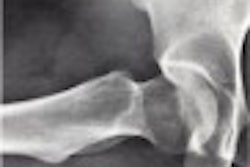ANAHEIM - Since 1995, when the Joint Commission on Accreditation of Healthcare Organizations (JCAHO) standards were implemented, only three kinds of guests have been invited to the compliance party: radiology administrators, staff, and JCAHO officials.
But under the new guidelines, another group will soon join in the fun -- patients. Starting in January 2004, a JCAHO survey team will arrive at a facility on its survey day, request a list of all active patients that are being cared for by the institution, and select from 11 to 15 patients to tail as "tracer patients."
"It would be extremely rare if none of these 11 patients did not have some experience with the radiology department," said Judith Atkins, a consultant with McKenna & Associates, a healthcare education and consulting firm in Charleston, WV.
Atkins spoke to an audience of mostly hospital-based radiology managers at the American Healthcare Radiology Administrators (AHRA) conference on Tuesday about these upcoming JCAHO changes. The Oakbrook Terrace, IL-based accrediting organization polices 17,000 healthcare organizations nationwide, including nearly 5,000 hospitals.
"By tracking representative patients, the Joint Commission intends to get a ground-level view of systems at an institution," she said.
Essentially, every area the tracer patient has come in contact with will be evaluated for compliance with JCAHO standards. The surveyors are expected to follow the patient’s path through a hospital. They will be able to conduct inquiries of any staff on any compliance issue for which they’re responsible at any time during the survey.
In addition, the surveyors will be interviewing patients on various compliance activities as they see fit. The accreditation score for an institution will be on the basis of the survey of the tracer patients.
"You could have beautiful policies and procedures, but if they don’t impact these tracer patients, they really aren’t worth much," Atkins said.
As part of its pre-survey activities, JCAHO will determine critical focus areas for its surveyors based on previous assessments by the organization. According to Atkins, these critical focus areas are:
- Assessment
- Communication
- Credentialing
- Equipment use
- Infection control
- Information management
- Medication usage
- Organization structure
- Orientation and training
- Rights and ethics
- Physical environment
- Quality improvement expertise and activity
- Safety engineering
- Staffing
"Any known deficiencies in any of these areas will probably be focused on by the surveyor," she said.
In addition to its new survey methodology, the organization has adopted the motto: "100% compliant, 100% of the time," according to Atkins. As part of this all-or-nothing philosophy, JCAHO has revamped its scoring system -- an institution is either compliant or non-compliant. There is no longer any scoring based on partial compliance with standards, although performance elements will still have the three-tier scoring of compliant, partial compliant, and non-compliant, noted Atkins.
She believes that much more time will be spent by JCAHO surveyors with staff than in previous accreditation surveys performed by the organization. As such, Atkins recommends that administrators use JCAHO-type language in their staff meetings so that staff is not caught unaware when questioned by a surveyor.
"For example, an MRI technologist may be asked by the surveyor about proactive risk reduction measures for the MR unit. What they’re asking is what steps have been done to ensure patient and staff safety around the MR magnet. The technologist knows these procedures, but the ‘JCAHOese" may confuse them if they’re not prepared ahead of time," she said.
In addition to its new methodology for surveying compliance, JCAHO requires that deficiencies noted during its survey be corrected within 90 days, rather than four months later.
A periodic performance review must be conducted by any JCAHO-accredited entity 18 months after its last survey, which has been required by all facilities surveyed since July 2002. Any deficiencies noted during this documented self-assessment of all standards areas require the development and implementation of a corrective action plan by the institution.
The rationale for these changes by the organization is to make surveying easier on its accredited groups, although Atkins expressed her doubts. "Anytime JCAHO says they’re going to make things easier for me, I get nervous," she said.
For the next two years, JCAHO surveyors will let the accredited institution know when its survey date is going to be. However, according to Atkins, starting in January 2006, all surveys by the organization will be unannounced and can occur at any time, regardless of the time elapsed since a previous survey.
"This will substantially change your readiness strategy," she predicted.
By Jonathan S. BatchelorAuntMinnie.com staff writer
August 13, 2003
Related Reading
Use of e-signatures requires awareness of legal ramifications, March 28, 2003
JCAHO expert offers troubleshooting for accreditation review, July 31, 2002
Group ties accreditation to patient safety, July 25, 2002
Disaster recovery in radiology, Part III: JCAHO requires emergency preparedness, January 31, 2002
Copyright © 2003 AuntMinnie.com



















